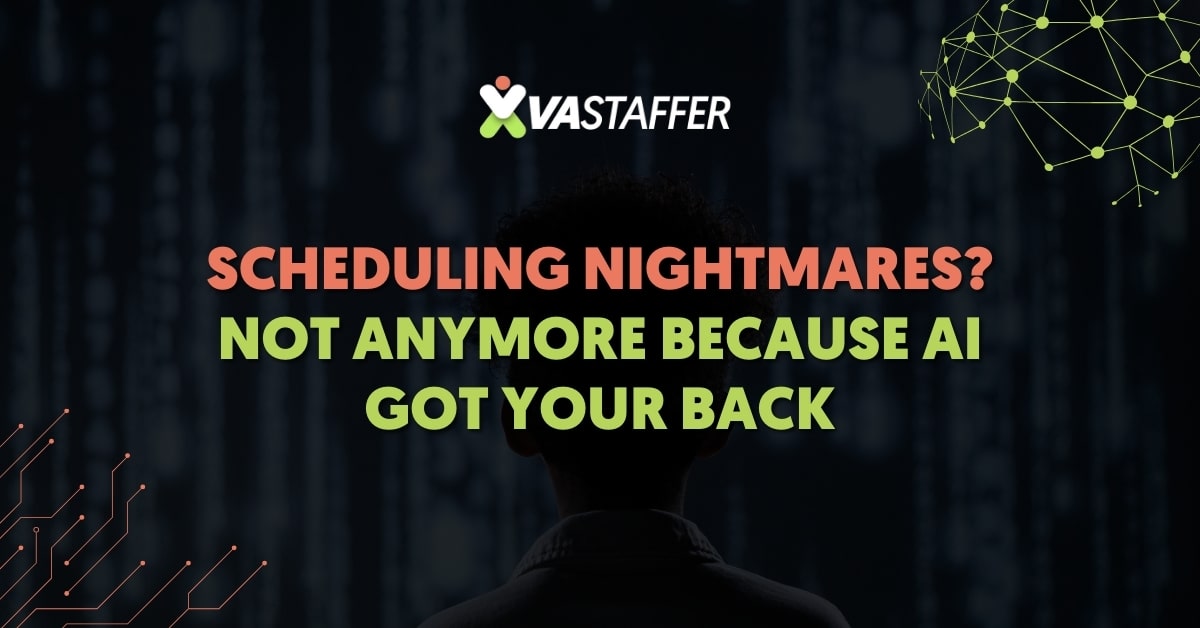Have you ever found yourself in an endless email thread trying to find a meeting time that works for everyone? Or accidentally double-booked yourself because you forgot to check your calendar?
Perhaps you’ve experienced that sinking feeling when you realize you completely missed an important appointment?
If any of these sound familiar, you’re not alone. And there’s good news! AI scheduling assistants are here to save your chaotic day.
What’s AI Scheduling? (And Why You’ll Love It)
The Simple Explanation: AI Taking Over Calendar Chaos
Think of AI scheduling tools as super-smart digital assistants dedicated to managing your calendar. These intelligent systems use artificial intelligence to handle the tedious back-and-forth of scheduling meetings, finding optimal times, and keeping your appointments organized.
It’s like having a personal assistant who never sleeps, never gets frustrated with calendar tetris, and is obsessively focused on making sure your schedule runs smoothly. The best part? This assistant lives on your computer or phone, ready to help 24/7.
Why Scheduling Is a Headache (And AI Fixes It)
Let’s be honest – traditional scheduling is inefficient and frustrating for several reasons:
The Email Ping-Pong Game: We’ve all been there. “How’s Tuesday at 2?” “Sorry, I’m booked then. How about Wednesday morning?” “Wednesday morning, I have another meeting. Thursday afternoon?” This back-and-forth can go on for days, wasting everyone’s time and cluttering inboxes.
Calendar Conflicts: Without a system to prevent it, double-bookings happen all too easily. You agree to a meeting, forget to record it, then schedule something else in the same slot. Or worse, you record it incorrectly and show up at the wrong time.
Availability Puzzles: Trying to coordinate multiple people’s schedules is like solving a complex puzzle. The more people involved, the more complicated it gets – especially across different time zones or when working with external partners.
Time Zone Confusion: Speaking of time zones, they’re a frequent source of scheduling errors. A meeting at “2 PM” might mean very different things to people in New York, London, and Sydney. Not to mention Daylight Saving time can add another complication to the situation.
AI scheduling tools address these pain points directly by automating the coordination process, checking for conflicts, and handling time zone conversions automatically.
What AI Scheduling Assistants Do
Modern AI scheduling assistants offer a range of powerful features:
Finding Available Time Slots: These tools scan connected calendars to identify when everyone is free, eliminating the guesswork and back-and-forth communications.
Automated Invitations: Once a time is selected, the AI can create and send calendar invites to all participants, complete with meeting details and location information.
Rescheduling Support: When plans change (and they always do), AI assistants can quickly find new times that work for everyone and update all relevant calendars.
Calendar Management: Beyond individual meetings, these tools help optimize your overall schedule, ensuring you have enough breaks, travel time between locations, and dedicated focus periods.
Cool Things AI Scheduling Assistants Can Do (With Automations!)
Finding the Perfect Time: No More Guessing
One of the most powerful features of AI scheduling tools is their ability to analyze multiple calendars simultaneously:
Intelligent Availability Detection: Modern scheduling assistants don’t just look for any free time – they identify optimal meeting times based on everyone’s preferences and patterns.
Priority-Based Scheduling: Some tools can even recognize which meetings are most important and ensure they get priority placement in your calendar.
Time Zone Intelligence: For global teams, AI assistants automatically adjust for different time zones, ensuring nobody gets a midnight meeting invitation (unless that’s actually preferred).
Buffer Time Management: The best tools automatically add travel time between physical meetings or buffer time between virtual ones, preventing the common problem of back-to-back meetings with no breaks.
Sending Invites Automatically: One Less Thing to Do
Once the AI finds a suitable time, the automation continues:
Complete Meeting Creation: The assistant creates calendar events with all necessary details – title, description, location (physical or virtual), and participant information.
Custom Invitation Messages: Many tools allow you to create templates for different meeting types, ensuring your invitations always contain relevant context and information.
Calendar Integration: Events are automatically added to all participants’ calendars in their native format – whether that’s Google Calendar, Outlook, Apple Calendar, or another system.
Follow-up Confirmation: Some assistants even confirm that invitations were received and accepted, giving you peace of mind that everyone is on the same page.
Rescheduling Made Easy: When Plans Change
When priorities shift (as they inevitably do), AI schedulers really shine:
One-Click Rescheduling: Rather than starting the scheduling process from scratch, most tools allow you to initiate rescheduling with a single click.
Smart Alternatives: The AI can immediately suggest new times that work for all participants, based on their updated calendars.
Cascading Adjustments: Some advanced assistants can even help manage the domino effect of rescheduling by suggesting adjustments to other affected meetings.
Automated Notifications: All participants receive clear updates about the change, eliminating confusion about which meeting time is current.
Automating Reminders: Never Miss a Meeting
Beyond scheduling, AI assistants help ensure meetings actually happen:
Multi-Channel Reminders: From email to text messages to app notifications, these tools can send reminders through whatever channels work best for you and your team.
Smart Timing: Reminders can be customized to arrive at the optimal time – not so early that they’re forgotten, but not so late that they cause panic.
Preparation Prompts: Advanced assistants can even remind you about pre-meeting tasks, such as reviewing documents or preparing presentations.
Travel Time Alerts: For in-person meetings, some tools will notify you when it’s time to leave based on current traffic conditions and your location.
Easy Ways to Use AI Scheduling Assistants
Choosing the Right Tool: Finding Your Calendar Buddy
With numerous options available, finding your perfect scheduling assistant requires considering:
Integration Capabilities: Does it work with your existing calendar system and other tools you use daily?
User Interface: Is it intuitive and easy to use for both you and the people you meet with?
Automation Level: How much of the scheduling process can it handle without your intervention?
Pricing Structure: Does the cost align with your budget and the value you’ll receive?
Popular options include Calendly, x.ai, Doodle, Clara, Zoom Scheduler, Microsoft Bookings, and HubSpot Meetings – each with their own strengths for different use cases and team sizes.
Connecting Your Calendars: Letting AI See Your Schedule
Getting started typically involves a simple setup process:
Calendar Authorization: You’ll need to give the scheduling tool permission to access and modify your calendar. This usually involves a secure OAuth connection to Google Calendar, Outlook, or other providers.
Privacy Settings: Most tools allow you to customize exactly what information is shared and what remains private. For example, you might show only busy/free status without revealing meeting details.
Working Hours Definition: You’ll want to specify when you’re typically available for meetings, so the AI doesn’t schedule 6 AM calls unless absolutely necessary.
Meeting Location Options: If you have regular meeting spots or video conferencing links, you can set these up as quick-select options.
Setting Up Your Preferences: Telling AI What You Need
Personalizing your scheduling assistant ensures it works the way you do:
Availability Rules: Define your preferred meeting days and times, blackout periods, and how much advance notice you need.
Meeting Types: Create templates for different kinds of meetings – client calls might be 30 minutes while team check-ins are 15 minutes, each with different preparation times.
Buffer Preferences: Specify how much space you want between meetings to avoid the dreaded back-to-back marathon sessions.
Approval Requirements: Decide which meetings can be automatically scheduled and which require your explicit approval before being confirmed.
Using Scheduling Links: Letting Others Book Time
One of the most powerful features is the ability to share booking links:
Personalized Scheduling Pages: Most tools create custom web pages where others can select from your available times based on current calendar availability.
Embedded Booking Widgets: You can add scheduling capabilities directly to your website, email signature, or LinkedIn profile.
Group Scheduling: For team meetings, some assistants can create polls or collective availability views to find times that work for everyone.
Customized Experiences: Control what information is collected during booking, from basic contact details to specific questions about meeting topics or goals.
Why AI Scheduling Is a Time-Saver
Saving Time: Getting More Done in Your Day
The time savings from AI scheduling assistants are substantial:
Eliminated Email Chains: Studies suggest the average scheduling email exchange takes 8 messages. Multiply that by dozens of meetings per month, and you’re saving hours of communication time.
Reduced Administrative Burden: Most professionals spend 4-5 hours per week managing their calendars. Automation can reduce this to minutes.
Faster Meeting Setup: What might take days of coordination can be accomplished in seconds with the right AI assistant.
Streamlined Rescheduling: When plans change, the ripple effects are managed automatically rather than requiring manual adjustments.
Reducing Stress: Feeling More Organized
Beyond pure time savings, there are significant psychological benefits:
Peace of Mind: Knowing your schedule is professionally managed reduces the mental load of keeping track of commitments.
Fewer Embarrassing Mistakes: Automated scheduling virtually eliminates double-bookings, missed appointments, and time zone confusion.
Reduced Decision Fatigue: With clear systems in place, you spend less mental energy on administrative details and more on meaningful work.
Calendar Confidence: You can trust that your schedule accurately reflects your commitments and priorities.
Improving Efficiency: Making Meetings Run Smoothly
The benefits extend beyond just getting meetings on the calendar:
Better Preparation: With reliable scheduling and reminders, everyone comes to meetings more prepared and focused.
Optimized Timing: AI can help schedule meetings at times when participants are likely to be most productive and engaged.
Streamlined Follow-ups: Many tools integrate scheduling with notes and action items, creating a seamless workflow from scheduling to execution.
Data-Driven Improvements: Over time, AI assistants learn your preferences and meeting patterns, making increasingly intelligent recommendations to optimize your calendar.
Wrap Up: Your AI Scheduling Adventure Begins!
Scheduling doesn’t have to be a source of stress and wasted time. AI scheduling assistants now offer a better way – intelligently coordinating calendars, automating invitations, handling changes, and ensuring everyone arrives prepared and on time.
Getting started is as simple as choosing a tool that fits your workflow, connecting your calendars, and setting a few basic preferences. Here at VA Staffer, our virtual assistants are trained on using AI tools so that one VA can manage multiple AI tools for you so you can run your business completely hands free.
Contact us today to learn more.


